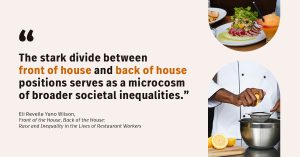Lessons from Front of the House, Back of the House: Race and Inequality in the Lives of Restaurant Workers

In the hospitality industry, the seamless interplay between front of house (FOH) and back of house (BOH) operations is crucial for delivering exceptional customer experiences. Eli Revelle Yano Wilson’s book, Front of the House, Back of the House: Race and Inequality in the Lives of Restaurant Workers, delves into the often overlooked dynamics within restaurant environments, exploring the racial and class divides that too often characterize these spaces.
Wilson’s insights offer valuable lessons on fostering an inclusive, efficient and motivated restaurant workforce. We’ve distilled key takeaways from the book into actionable steps that can help restaurateurs promote fair and equitable labor practices and contribute to a more sustainable and ethical industry.
- About the author
- Implicit bias in restaurant hiring and promoting
- Physical and invisible barriers between front and back of house workers
- Impacts and consequences of race- and class-divided teams
Hire and build an all-star restaurant team
Learn how to attract great restaurant workers and how to build a culture that will keep them happy.

About the author
Eli Revelle Yano Wilson is a sociologist with a keen interest in labor, race and inequality. In Front of the House, Back of the House, Wilson leverages extensive fieldwork and interviews to unravel the complexities within restaurant settings, highlighting how racial and class stratifications influence the roles and experiences of workers. By examining these dynamics, Wilson provides a nuanced perspective on the invisible labor that underpins our dining experiences.
Implicit bias in restaurant hiring and promoting
Wilson’s research reveals that front of house positions are often dominated by class-privileged white workers, while back of house and support roles (e.g. cooks, dishwashers, bussers) are predominantly filled by people of color.
The author suggests that this division of restaurant labor along racial and class lines is facilitated by hiring decisions that unconsciously favor white workers for front of house positions, which are more visible and typically offer higher earnings through tips. This preference is driven by stereotypes about appearance, language skill and perceived professionalism, leading to a homogeneous front of house staff that lacks racial diversity.
Implicit bias also affects advancement opportunities, observes Wilson, with management more likely to promote workers who “look like they belong” to coveted front of house roles over more experienced or more capable workers who don’t look the part.
Based on his observations and interviews, Wilson outlines various strategies and policies restaurants can adopt in order to tackle latent bias in hiring and promoting decisions, such as:
- Diversify recruitment channels: Restaurateurs should use varied recruitment channels rather than drawing on what Wilson calls “ethnic resources.” When restaurants hire almost exclusively from the networks of front and back of house workers to fill open positions—routing new staff members into ‘houses’ based on who they were recommended by—Wilson says “it all but guarantees that the children of immigrants begin their restaurant employment at the bottom of the workplace hierarchy.”
- Establish clear promotion criteria: Creating transparent and merit-based criteria for promotions can help ensure that all employees have equal opportunities for advancement. This includes outlining specific skills, experiences and performance metrics required for promotion.
- Promote from within: Encouraging internal promotions and offering cross-training between the front and back of house can help back of house workers see a clear path for advancement. By investing in the growth of existing employees, restaurants can demonstrate a commitment to equity and inclusion.
- Foster an inclusive culture: Building a good workplace culture that values and respects diversity is essential. This involves creating an environment where all employees feel welcome and valued, regardless of their background or role. Celebrating diverse perspectives can help foster a more inclusive workplace.
Physical and invisible barriers between front and back of house workers
While the labor process within restaurants requires back and front of house workers to coordinate their actions hundreds if not thousands of times a day, Wilson notes that they do so across divided lines. “Behind the scenes, they are worlds apart,” says Wilson, separated by unmistakable barriers that are often invisible to guests, including:
- Physical spaces. The front and back of the house are divided into distinct and separate spaces. Front of house workers own the dining room, and back of house workers own the kitchen. Neither is seen to belong in the other’s space. In toxic environments where “violent and sarcastic responses have become commonplace,” Wilson notes that front and back of house workers learn to avoid direct contact with their colleagues at all costs.
- Schedule and job conditions. Back of house workers generally work longer hours and do more physically demanding work. It’s in their best interest to stay clocked in and to pace themselves. Front of house workers, on the other hand—especially those earning less than the federal minimum wage—have little incentive to be on the clock if conditions aren’t favorable for tips “by the fistful.” It’s in their best interest to get in, clear as many covers as possible and get out.
- Earning potential. Wage disparities are prevalent in the restaurant industry, with front of house staff typically earning more through tips than their back of house counterparts, creating a sense of unfairness and resentment among back of house workers. There also tends to be less investment in the career advancement of back of house workers, perpetuating a cycle where people of color remain in lower-paying, less visible positions.
- Workflows and responsibilities. While the daily workflow of cooks adheres to the requirements of food production “rather than the whims of guests”, front of house workers know they need to use their personality and appearance to succeed in their job. They are focused on ensuring that guests have a good time and leave satisfied, even if it puts them in direct opposition to their back of house colleagues.
“These cumulative points of difference between what front and back of house workers do causes them to make character assumptions about the other that draw directly from these differences,” says Wilson.
“Rather than seeing themselves as unified coworkers [against] exploitative managers, workers expound negative generalizations about those on the other side.” This can lead to a distinct ‘us vs. them’ mentality that further divides front and back of house workers into two opposing teams.
In order to improve team cohesion and boost employee retention, Wilson emphasizes the importance of fair wage practices, improved job security and benefits and clear advancement pathways.

Impacts and consequences of race- and class-divided teams
The impacts and consequences of racial and class divisions in restaurants are multifaceted and significant. These divisions can lead to a fragmented work environment, exacerbate workplace tensions and perpetuate inequality.
- Fragmented work environment: The clear division between front of house and back of house staff can create a fragmented work environment where cooperation and mutual respect are lacking. This separation can lead to a lack of cohesion and understanding among employees, impacting teamwork and overall efficiency.
- Bad service: When the back and front of house have only a rudimentary understanding of what the other does, slow service or nightmarish disruptions can become common. Strained interpersonal relationships between cooks and servers also make those on one side unwilling to go out of their way to help the other.
- Reinforcement of stereotypes: The division of labor along racial lines can reinforce harmful stereotypes and biases. It perpetuates the notion that certain racial or ethnic groups are more suited to particular types of work, which can have broader social implications beyond the restaurant industry.
- Low employee morale and retention: Inequities and tensions arising from these divisions can negatively impact employee morale and lead to a high turnover rate, especially in the back of house. High turnover disrupts restaurant workflows, increases training costs and can damage a restaurant’s efficiency and reputation.

Why restaurants should embrace diversity, equity and inclusion
Implementing diversity, equity and inclusion (DEI) initiatives can help bridge the gap between front of house and back of house staff, fostering a more cohesive and supportive work environment. By promoting fair hiring practices, equitable pay and career advancement opportunities for all employees, restaurants can create a more motivated and loyal workforce. In today’s tight labor market, keeping great staff is more important than ever.
Embracing DEI can also enhance the customer experience—especially as “the growth of middle-class and upwardly mobile consumers of color will invariably mean […] changing tastes for not only food but also service and ambiance.”
A diverse staff can bring a variety of perspectives and ideas, leading to more innovative and culturally sensitive service. This inclusivity not only attracts a broader customer base but also helps to build a positive reputation for the restaurant, setting it apart in an increasingly competitive market.
Balancing fair and equitable wage practices with rising food prices and other cost pressures is a tough job. But adopting innovative technology can help you optimize your workflows and make life easier for your teams .
Reach out to one of our POS experts today to learn how Lightspeed’s restaurant management platform is helping restaurants transform their operations and reach their goals.

News you care about. Tips you can use.
Everything your business needs to grow, delivered straight to your inbox.


